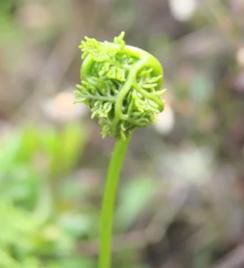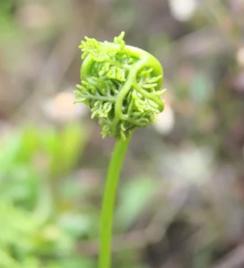[dropcap style=”font-size:100px; color:#992211;”]P[/dropcap]resumably the newly-discovered plants with ‘fluid definitions of gender’ were born that way.
The scientists who discovered a new genus of ferns named them after Lady Gaga for numerous reasons. Surprisingly, having no middle-eight and resembling Express Yourself-era Madonna weren’t amongst them.
Instead, it’s their genetic code, relaxed attitude to tiresome sexual conventions and heart-shaped gametophyte that inspired the choice of name. Hopefully they’ve cleared the rights.
Gaga germanotta, a new fern, and a branding opportunity par excellence for Lady Gaga, if any of her little monsters can figure out what to do with it.
19 species of ferns named for Lady Gaga
DURHAM, N.C. — Pop music megastar Lady Gaga is being honored with the name of a new genus of ferns found in Central and South America, Mexico, Arizona and Texas. A genus is a group of closely related species; in this case, 19 species of ferns will carry the name Gaga.
At one stage of its life, the new genus Gaga has somewhat fluid definitions of gender and bears a striking resemblance to one of Gaga’s famous costumes. Members of the new genus also bear a distinct DNA sequence spelling GAGA.
Two of the species in the Gaga genus are new to science: Gaga germanotta from Costa Rica is named to honor the family of the artist, who was born Stefani Germanotta. And a newly discovered Mexican species is being dubbed Gaga monstraparva (literally monster-little) in honor of Gaga’s fans, whom she calls “little monsters.”
“We wanted to name this genus for Lady Gaga because of her fervent defense of equality and individual expression,” said study leader Kathleen Pryer, a Duke University biology professor and director of the Duke Herbarium. “And as we started to consider it, the ferns themselves gave us more reasons why it was a good choice.”
For example, in her performance at the 2010 Grammy Awards, Lady Gaga wore a heart-shaped Armani Privé costume with giant shoulders that looked, to Pryer’s trained eyes, exactly like the bisexual reproductive stage of the ferns, called a gametophyte. It was even the right shade of light green. The way the fern extends its new leaves in a clenched little ball also reminds Pryer of Gaga’s claw-like “paws up” salute to her fans.
The clincher came when graduate student Fay-Wei Li scanned the DNA of the ferns being considered for the new genus. He found GAGA spelled out in the DNA base pairs as a signature that distinguishes this group of ferns from all others.
Like most ferns, the Gaga group is “homosporous.” They produce tiny spherical spores that drift to the ground and germinate into heart-shaped plants called gametophytes. These independent little organisms can be female, male or even bisexual, depending on growth conditions and what other kinds of gametophytes are around. When conditions are right, they exchange sperm between gametophytes, but when necessary they sometimes can also self-fertilize to produce a new fern.
“The biology of these ferns is exceptionally obscure and blurred by sexual crossing between species,” Pryer said. “They have high numbers of chromosomes and asexuality that can lead to offspring that are genetically identical to the parent plant.”
The research was funded in part by National Science Foundation, grant DEB-0717398.
CITATION: “Gaga, a New Fern Genus Segregated from Cheilanthes (Pteridaceae),” Fay-Wei Li, Kathleen M. Pryer and Michael D. Windham. Systematic Botany, Oct-Dec, 2012.
Source: Duke University

The aim of art is to represent not the outward appearance of things, but their inward significance. – Aristotle




















